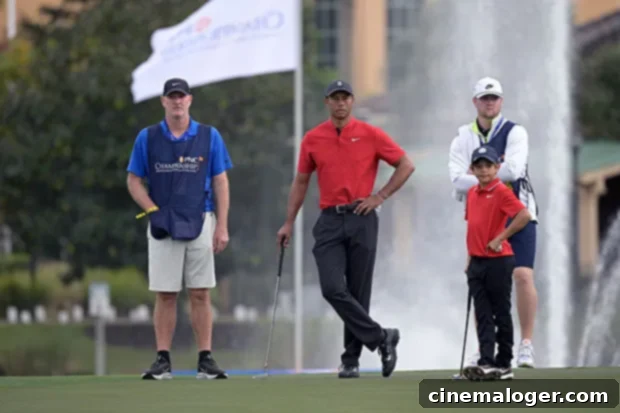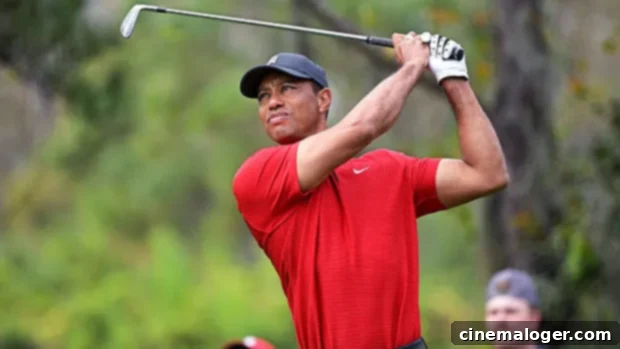Tiger Woods’ Remarkable Recovery Journey: From Devastating Crash to Hopeful Return to the Green
Golf legend Tiger Woods, 45, is defying expectations, making an inspiring comeback from the life-threatening single-vehicle rollover car crash he endured in February. The accident, which caused “significant orthopedic injuries,” left many questioning his future, not just in golf, but in daily life. However, recent sightings and insider reports paint a picture of extraordinary resilience and progress, signaling a hopeful return to form for the iconic athlete.
The most significant sign of his remarkable recovery came over a recent weekend when Woods was spotted at a Florida golf course, not yet playing, but supporting his 12-year-old son, Charlie, who was competing in a junior tournament. This appearance was a powerful moment, symbolizing his slow but steady reintegration into the sport he loves, even if from the sidelines. Sources close to Woods confirm that his progress has been truly astonishing in recent months. “Tiger has made a remarkable recovery in the past few months, but it’s even more significant lately,” an insider shared with PEOPLE. “It’s like every day he can do more, he can handle more, the pain is less and he’s feeling better.” This sentiment underscores the intensity and dedication Woods has poured into his rehabilitation.
The Severe Injuries and the Immediate Aftermath
The accident itself, which occurred in Southern California, left Woods with critical injuries that required immediate and extensive medical attention. According to Anish Mahajan, MD, chief medical officer at Harbor-UCLA Medical Center, Woods “suffered significant orthopedic injuries to his right lower extremity.” Specifically, he sustained “comminuted open fractures” to both his tibia and fibula bones. This type of injury is particularly severe, meaning the bones were shattered into multiple pieces and broke through the skin, presenting a complex surgical challenge. In addition to these major fractures, Woods also suffered smaller injuries to his ankle and foot, necessitating multiple surgeries to stabilize the damaged limb. The initial days and weeks post-accident were undoubtedly filled with intense pain and uncertainty, with doctors focusing on preventing infection and ensuring proper alignment for healing.

From Agonizing Pain to Manageable Discomfort
The initial phase of recovery was marked by excruciating pain and severe limitations. For months, the golf icon was largely confined to his home, his leg elevated, grappling with relentless throbbing pain. “For the first couple months, he’d just be sitting at home with his leg up, and it would be throbbing and he’d be in so much pain,” the same source elaborated. This period tested not only his physical endurance but also his renowned mental fortitude. However, a consistent regimen of rigorous physical therapy, initiated almost immediately after his surgery, has been instrumental in his progress. This dedicated rehabilitation has slowly but surely transformed his condition. “He says that the pain is very manageable now,” the source confirmed. “Now he still has pain, but it’s nothing like what he dealt with before. He’s feeling strong and healthy and optimistic that he’ll be able to return to [the PGA] tour.” This shift from debilitating pain to a manageable level is a monumental step forward, signifying significant healing and the increasing effectiveness of his therapy.
A Glimpse of Hope: Back on the Green
The recent appearance at the junior golf tournament, where he watched his son Charlie compete, was more than just a public sighting; it was a potent symbol of his return to life outside of intensive rehabilitation. For an athlete whose entire identity is intertwined with the golf course, being back in that environment, even as an observer, is a crucial psychological milestone. It demonstrates a desire to engage with the sport and his family’s involvement in it, providing him with a tangible connection to his passion. This moment, captured by onlookers, offered fans around the world a powerful image of resilience and a testament to his determination to recover. It’s a clear indication that his mind is already gravitating back to the game, even as his body continues its healing process.
Tiger’s Unwavering Determination and Personal Goals
Despite the physical challenges, Woods’ spirit remains indomitable. His primary focus, initially, was incredibly basic: to regain the ability to walk independently. In his first interview following the accident, conducted with Golf Digest in May, he shared his fundamental objective. “I do my routines every day and am focused on my No. 1 goal right now: walking on my own. Taking it one step at a time,” he stated. This philosophy of focusing on incremental progress, rather than being overwhelmed by the enormity of the task, has been key to his recovery. The fact that he is now not only walking but also attending golf events speaks volumes about the progress made towards this foundational goal. His ultimate aspiration, however, remains a return to the competitive PGA Tour.

The Speculation Continues: A PGA Tour Comeback?
While the enthusiasm for his potential return to the PGA Tour is palpable among fans and the golf community, there is no confirmed timeline yet. Woods himself maintains a degree of discretion about his exact plans, but insiders suggest he has a clear vision for his comeback. “He’s got a timeframe in his head, but he’s not really putting that out there; he knows when he wants to return, and he’s going to make it happen,” the insider added. This controlled approach reflects the gravity of his injuries and the need for a meticulously planned return to elite competition. What’s particularly telling is his determination to compete even if he isn’t operating at 100% of his previous capacity. “He says even if he’s not at 100%, he knows how important it is to get back out there and compete. That’s his goal.” This statement is a testament to his fiercely competitive nature and his understanding of his role within the sport. Even a slightly diminished Tiger Woods on the course would be a spectacle, drawing immense attention and inspiring millions. His goal isn’t just to play, but to compete, embodying the spirit that has defined his legendary career.
A Legacy of Resilience and Inspiration
Tiger Woods’ career has been punctuated by numerous comebacks from significant injuries, each time demonstrating his unparalleled mental toughness and physical dedication. From knee surgeries to spinal fusion, he has repeatedly overcome adversity to return to the pinnacle of golf. This latest challenge, however, is arguably his most formidable. The severity of his leg injuries, particularly the “comminuted open fractures,” presented a threat not just to his career, but to his everyday mobility. Yet, his progress serves as a powerful source of inspiration, extending far beyond the golf world. His journey is a testament to the human spirit’s capacity for recovery and determination in the face of overwhelming odds. As he continues his rehabilitation, the golfing world, and indeed the broader sports community, watches with bated breath, hopeful for another chapter in the incredible story of Tiger Woods.
